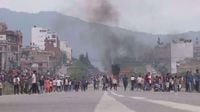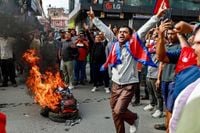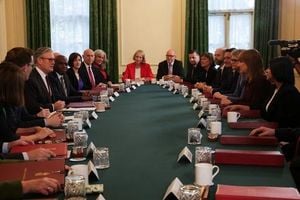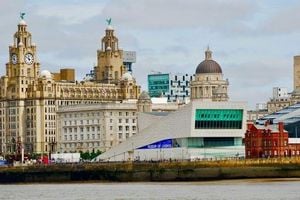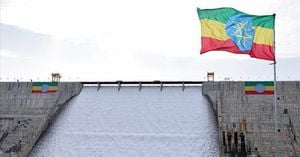In a week marked by extraordinary upheaval, Nepal has witnessed its most intense political crisis in decades, as Gen Z-led protests against a controversial social media ban and entrenched government corruption erupted into deadly violence, ultimately forcing Prime Minister K.P. Sharma Oli to resign. The unrest, which began on September 4, 2025, has left at least 19 people dead in Kathmandu alone, with dozens more injured, and has plunged the Himalayan nation into fresh political uncertainty.
The spark for this dramatic sequence of events was the Nepalese government’s decision to block major social media platforms—including Facebook, Instagram, WhatsApp, X (formerly Twitter), and YouTube—that had not registered with local authorities. Officials justified the move by citing concerns over fake identities, hate speech, and online fraud, and claimed the registration requirement was intended to facilitate taxation of revenue generated by these platforms.
However, for Nepal’s digitally savvy youth, who make up a significant portion of the country’s 30 million citizens and rely heavily on these platforms for news, entertainment, and business, the ban was the final straw. According to Reuters, protesters saw the move as an assault on free expression and a thinly veiled attempt to muzzle government critics. Many young Nepalis, frustrated by years of economic stagnation, high unemployment, and what they see as rampant corruption among the political elite, poured into the streets in defiance of curfew orders imposed across Kathmandu, Lalitpur, and Bhaktapur districts.
On September 8, 2025, these frustrations boiled over into violence. As thousands of demonstrators—many in school or college uniforms—marched through the capital, police responded with water cannons, tear gas, and rubber bullets. The result was tragic: at least 19 people were killed in Kathmandu, and two more in Itahari, with more than 100 injured. According to The Kathmandu Post, the violence also led to widespread vandalism, including attacks on government buildings and the homes of political leaders. Prime Minister Oli’s private residence was set ablaze, former Prime Minister Prachanda’s house was attacked, and the ruling Nepali Congress party’s central office in Sanepa was torched by angry mobs.
Despite the imposition of an indefinite curfew—under which schools and shops were shuttered and public gatherings banned—protesters continued to gather in large numbers. They carried national flags and placards with slogans such as “Shut down corruption and not social media,” as reported by Reuters. Some even attempted to storm parliament, while others set fire to security vehicles and an ambulance. The Kathmandu airport, the country’s main international gateway, was forced to close due to smoke from fires set by demonstrators.
The government’s response was swift but ultimately futile. Several ministers, including Home Minister Ramesh Lekhak, Minister for Agriculture Ramnath Adhikari, and Minister for Water Supply Pradeep Yadav, resigned from their posts as the crisis escalated. Nepali Congress General Secretary Gagan Thapa publicly called on Prime Minister Oli to take moral responsibility for the deaths and step down. Rumors swirled that Oli was preparing to flee the country.
In a bid to calm the situation, Oli called an all-party meeting on September 9, 2025, emphasizing that “no form of violence serves the nation’s interest, and we must pursue a peaceful and dialogue-based solution.” Yet, as the protests showed no signs of abating, Oli submitted his resignation letter to President Ramchandra Paudel, stating, “In view of the adverse situation in the country, I have resigned effective today to facilitate the solution to the problem and to help resolve it politically in accordance with the constitution.”
President Paudel quickly began the process of finding a new premier and summoned protest leaders for talks. Army chief Ashok Raj Sigdel, in a video address, urged demonstrators to end the unrest and come to the negotiating table. Meanwhile, the U.S. State Department issued a statement urging all sides to refrain from violence and reaffirming America’s commitment to Nepal’s stability and democratic governance.
Following the prime minister’s resignation, jubilant youths stormed the parliament complex, waving their hands and shouting slogans as smoke billowed from parts of the building. “We won,” one protester scrawled in huge orange letters on the parliament walls, according to Reuters. Security forces, perhaps wary of further escalation, kept their distance as the crowds celebrated their apparent victory.
Yet, the underlying issues that fueled the protests remain unresolved. The social media ban, which was lifted early on September 9, had been a lightning rod for wider grievances about political corruption, lack of opportunity, and economic hardship. Many young Nepalis have been forced to seek work abroad—in the Middle East, South Korea, and Malaysia—sending money home to support their families. The protests, organizers say, were intended “first and foremost, against the rampant corruption in government.” As one demonstrator explained in an email to Reuters, “Young Nepalis had been posting on social media about the luxurious lives of the families and children of corrupt politicians and civil servants until the government clamped down on the platforms.”
The international community has watched the events in Nepal with concern. India’s Ministry of External Affairs advised its citizens to defer travel to Nepal and provided emergency helpline numbers, while urging those already in the country to stay indoors. The U.S. and other nations have urged dialogue and restraint, but the path forward remains uncertain.
Nepal’s current turmoil is the latest chapter in a long history of political instability. Since the abolition of its monarchy in 2008, the country has cycled through 14 prime ministers and endured frequent government shake-ups. The recent protests are the most violent since that historic transition, and their Gen Z leadership marks a generational shift in Nepal’s political landscape.
For now, the streets of Kathmandu are quieter, but the questions raised by this crisis—about censorship, corruption, and the voice of a new generation—are far from settled. The world is watching as Nepal’s leaders, and its youth, chart the country’s next steps.

